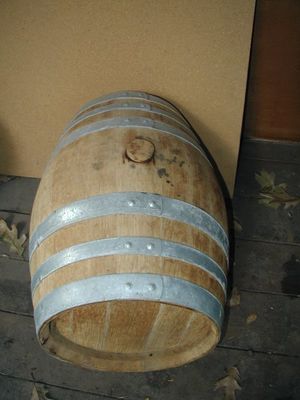Maturation: Difference between revisions
Uncle Jesse (talk | contribs) (Restoring page from http://web.archive.org/web/20100706175413/http://wiki.homedistiller.org/Maturation) |
Uncle Jesse (talk | contribs) No edit summary |
||
| Line 37: | Line 37: | ||
The process by which [[wine]] matures, in bulk or in bottles or both, to achieve smoothness (in acidity), mellowness (in [[tannin|tannins]] and other phenols) and unique character and complexity. The major activities in this process are the chemical reduction of certain compounds into others, primarily by [[hydrolysis]] or [[oxidation]], and the joining together of short | The process by which [[wine]] matures, in bulk or in bottles or both, to achieve smoothness (in acidity), mellowness (in [[tannin|tannins]] and other phenols) and unique character and complexity. The major activities in this process are the chemical reduction of certain compounds into others, primarily by [[hydrolysis]] or [[oxidation]], and the joining together of short molecular chains into longer ones. [[Volatile Esters]], [[ethers]] and [[acid|acids]] create [[bouquet]], which is not the same as aroma. | ||
A portion of the volume of liquid in a cask is lost to evaporation, and is colloquially known as the [[Angels Share]]. | A portion of the volume of liquid in a cask is lost to evaporation, and is colloquially known as the [[Angels Share]]. | ||
Revision as of 13:42, 26 August 2017
The aging of spirits in order to improve their quality. Spirits are often aged in oak barrels.
There are three processes that occur when oak barrels are used to age spirits:
- Evaporation of spirit through dry section of barrel
- Leaching of oak chemicals into spirit
- Diffusion of spirits through barrel
If you can not store your spirit for years in a 55 gallon oak barrel, there are some alternatives which provide a reasonable approximation of barrel aging:
- Put oak chips in your spirit bottle
- Put charred oak chips in your bottles to simulate bourbon
- Stopper your bottles with a dry cork to promote evaporation
- Add sherry to you spirit
If you are using barrels, it is nice to have a glass thief which will help you extract small amounts for periodic tasting.
During the maturation process, some of the following chemical changes occur:
- The aldehyde level changes
- The color changes
- The concentration of esters changes
- The acidity changes
- The concentration of furfural changes
- The concentration of fusel oils changes
- The pH changes
- The amount of solids changes
- The proof changes
- The concentration of tannins changes
- The total acidity changes
The process by which wine matures, in bulk or in bottles or both, to achieve smoothness (in acidity), mellowness (in tannins and other phenols) and unique character and complexity. The major activities in this process are the chemical reduction of certain compounds into others, primarily by hydrolysis or oxidation, and the joining together of short molecular chains into longer ones. Volatile Esters, ethers and acids create bouquet, which is not the same as aroma.
A portion of the volume of liquid in a cask is lost to evaporation, and is colloquially known as the Angels Share.
